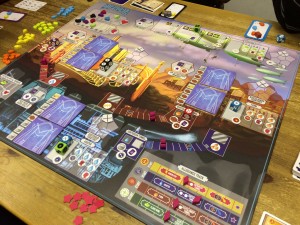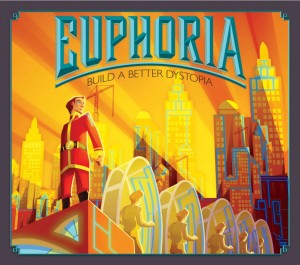Review: Euphoria
Posted by James (admin) on January 21st, 2014
 Set in a dystopian future, Euphoria is primarily a worker placement game, with lots of moving parts and a few new ideas. The winner is the first player to place all 10 of the authority tokens on the board and these can be placed in a variety of ways.
Set in a dystopian future, Euphoria is primarily a worker placement game, with lots of moving parts and a few new ideas. The winner is the first player to place all 10 of the authority tokens on the board and these can be placed in a variety of ways.
Players have workers (dice) which they place on the board to be able to earn commodities (food, water, energy, bliss) as well as resources (gold, stone, clay). The board shows a city divided into 4 main areas – each area belongs to a faction and each faction specialises in one of the commodities.
Euphoria is a gamer’s game. It’s not massively complicated but there are a lot of working parts to the game mechanics. Rather than try to explain the whole game, I’ll explain some of the main gameplay areas one-by-one to give the highlights.
WORKERS & PLACEMENT
On their turn, a player can place one of their workers (more if they have the same value – remember the workers are dice), or they can retrieve one or more of their workers from the board. All actions require a worker to be placed on the relevant location and most actions cost resources/commodities to use them. For many locations, a worker is returned to its owner if another worker is placed on the same location; for some other locations, multiple workers can be placed and the benefit earned is based on the total value of all the workers present; and for a few locations, only one worker can occupy the location.
So, whilst Euphoria is a worker placement game, it is different to others because it’s not really about blocking other players by grabbing actions before someone else does, and players are all placing and removing workers at different times so there’s no end of round where all players take their workers back. I like traditional worker placement game but Euphoria’s approach is very nice too and feels different.
KNOWLEDGE & MORALE
Each player has a morale level and a knowledge level which go up and down depending upon the actions the player takes. Morale dictates how many artifact cards you can have in your hand. Knowledge is more complicated, but very important.
Each worker’s value represents its knowledge about the world. Whenever a worker returns to a player from the board, the player must roll the dice to set its new value – if the total of the workers available to be placed by a player plus the player’s current level of knowledge is too high (over 15), then the most knowledgeable worker runs away because they know too much, i.e. you lose a worker/dice. Low value workers are great because there’s little chance of them running away; however, there are a few locations where higher value workers can earn you more.
The worker knowledge system is a very interesting game mechanic as it makes having lots of workers more risky (you start with 2 but can hire more during the game). Also, it makes you consider how many you bring back off of the board using an action at any one time. Plus, you can even try to force opponents to lose workers by using a location so a worker is returned to them whilst they have a very high total of workers in front of them. This was a source of a lot of entertainment for my group.
RECRUITS & ALLEGIANCE
Each player starts the game by choosing 2 out of 4 recruits (character cards). Each recruit gives the owning player a special ability, plus the player also gets other benefits depending upon how far the matching faction’s marker has moved along the allegiance track. (Various actions move the faction markers along the allegiance track .)
Players choose one of their two starting recruits to be active at the start of the game, and the other only becomes active when either (a) their faction’s allegiance marker is advanced enough, or (b) their faction’s tunnel is progressed enough. When this happens, all players get to activate (reveal) any recruit cards that match the relevant faction so the player can use their benefits and special ability too.
I always like games that give each player a slightly different set of tools so that they look at the same board but each in a different way and the recruits do this. Also, it makes you want to advance your initial recruit’s faction’s allegiance track to get immediate benefits, but you also want to advance your hidden recruit’s faction’s allegiance track so it can become active; however, doing both of those things can help other players too. If an faction’s allegiance marker is fully advanced, players can place authority tokens on each of the recruits they have of that faction.
I did feel that some of the recruits’ abilities seemed much more powerful than others. I think some may simply suit different tactics better than others, so there’s a bit of luck in getting ones that match your tactics.
 MARKETS
MARKETS
Players can place a worker with a resource to construct part of one of the 6 markets. When completed, the market is flipped over allowing access to an action on the board that any player can use from then on, plus all players that helped in the construction get to place one of their authority tokens on it. However, players who did not help build a market suffer a restriction printed on it, i.e. they can’t gain any new workers, they can’t bump their own workers from action spaces, etc. Players suffering these restrictions can remove them if they do a special action.
The markets were very funny in our game as no-one wanted to be left out of building a market once building started. As there were only 4 building actions for each market and 5 players, as soon as one player built the first part of one, there was a sudden rush to help build them. I admit I caused a lot of this as I was watching what resources other players had so I initiated building markets that I knew other players could help finish if they wanted to. As well as to place authority tokens, I did this (a) to ensure others got stung with restrictions and I didn’t, (b) to ensure my workers were less likely to remain committed for long (as they only count towards building whilst at the location), and (c) to ensure other players didn’t build markets for which I didn’t have any required resources.
Some of the restrictions can be fairly innocuous; however, some can be incredibly punishing. The markets are randomly selected each game and start face-down so, whilst the actions that will be revealed are always the same as they’re printed on the board, no-one knows what the restrictions will be. Having them face-down until built is okay but, for me, this added an element of unwanted luck to the game – I wonder if it may be better if a market is flipped face-up as soon as the first section is built so players can see what’s at stake and have more information. (They could all start face-up too but that’s not quite as exciting, plus flipping after the first part is built adds a potential risk for the player starting the construction.)
TUNNELS
There are tunnels between 3 of the factions. Players using the dig tunnel actions get resources and/or artifact cards, plus they advance the tunnel one step. If the tunnel is advanced enough, it allows players to reveal recruits of the matching faction. When the tunnel is complete, it reveals a new action which allows players with recruits of the owning faction to gain commodities of the area that was tunneled into.
AUTHORITY TOKENS
There are several places where you can place your authority tokens to try to win the game. They can be placed on each market (if you help build them or do a special action later), on a territory (if you do the appropriate action and there are spaces remaining), on recruit cards (if their faction’s allegiance track marker is at maximum), and on the dilemma card (a one-off power all players get allowing a player to gain an extra recruit or place an authority token on it). At the start of the game, placing these seems slow going but the pace increases as the game progresses and players start to accumulate enough commodities, resources and artifact cards.
CONCLUSION
Euphoria is an excellent worker-placement game with some new ideas and its own identity. Turns are short so the game moved quickly. I felt I had choices but never felt bewildered by them which meant I could decide and plan my next turns. Whilst there are lots of game mechanics and resources, gamers will get to grips with it quickly as all the elements are simple in their own right. This understanding is aided by each of the faction areas operating in the same way, plus the rules are written clearly too.
The dystopian theme is a more unusual one for board games. Unfamiliar themes can make it harder to understand games because players don’t have any common references on which to base their logic, i.e. you know before playing a trading game that you need goods and ships to deliver contracts. However, Euphoria’s theme actually works very well – the resources and commodities required to do things are a bit abstract, but it’s the total knowledge game mechanic that really sells it (plus the allegiance tracks and card names), and then the clear iconography makes the rest easy to assess. As a result, the unusual theme works and makes the game stand out too.
The artwork is very nice and on theme. The board art is quite busy as a background; however, I didn’t find it to be a problem. The physical components of the standard edition were very good – the wooden lightning bolt pieces and workers with shovels were especially good. I’ve seen the even more upgraded special edition components and those are even nicer with upgraded resource tokens.
There are a few areas that bring in some elements of luck (the market restrictions can be crippling without warning; the recruits’ powers may or may not match your strategy, and placing more than one worker because they have the same value is a random advantage). However, these aren’t too important which meant I really enjoyed Euphoria. I am looking forwards to playing it more and to trying the game with 2 and 3 players to see how it compares.
James.
[Played with 5 players]

